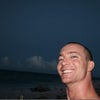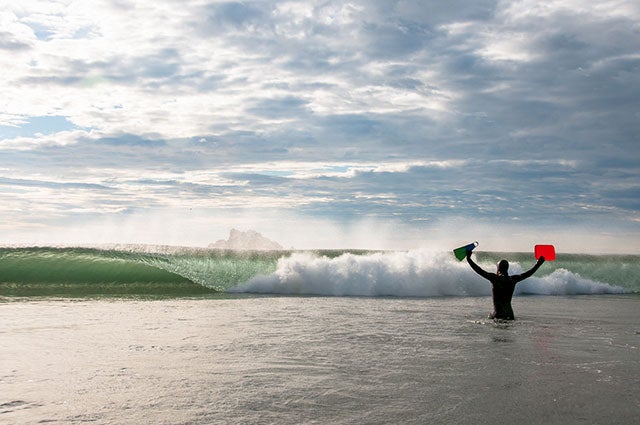PHOTOGRAPHER CHRIS BURKARD IS ALWAYS HUNTING for something different, a remote location with a surreal landscape, an unspoiled spot on a map that’s getting smaller and smaller. About four years ago a surf trip to Kamchatka hit his nose. He knew it was a scent worth following after talking to hunters and fisherman who had visited Russia’s answer to Alaska. They said the coast had potential, but would be difficult and expensive to navigate. Burkard took to Google Earth. He marked old craters, deltas with sand bars, and sudden points of land jutting out into the ocean—basically any earth that might tickle swells into surfable waves. His idea sat for three years, until he stumbled onto a bed and breakfast owner named Martha Madsen (http://www.explorekamchatka.com/kamchatka-bed-breakfast.htm). “The trip didn’t really come together until we were able to get a really good fixer,” he said. “We said this is what were trying to do and this is what kind of vehicle we need, and she was like, ‘I can get you this Soviet military troop carrier.’”
Surfing Kamchatka Gallery
View photographer Chris Burkard’s stunning images.Photographer Chris Burkard
 Another early morning
Another early morningShe arranged for a 21-person, four-wheel-drive truck that could power through rutted out forest roads crowded with saplings, plow through flooded lowlands, and charge up steep embankments. For areas where the truck wouldn’t suffice, Madsen chartered an old Soviet cargo helicopter to fly the crew. Burkard had only one last concern “I started to research the place and all I could find was stuff on grizzly bears,” he said. “Articles about bear attacks, and people being ripped out of their tents by bears, and 15 bears surrounding a cabin of scientists.”
So he asked Madsen for guns. “She was like, ‘Oh, we’d never shoot a bear,’” says Burkard. “And I was like, ‘I know, me neither, but just for protection.’”
Madsen told Burkard to bring a car battery and a metal wire long enough to wrap around their truck and their campsite. “That was it,” says Burkard. “The only thing keeping us from 900-lb. grizzly bears was a few millimeters of wire.”
Which is where we pick up the conversation…
OUTSIDE: So did you see any bears?
BURKARD: We took a helicopter and found this riverbank. There were all of these rad flat spots to camp. And we were like, “Whoaa, this is going to be killer.” And then we noticed all of these dead birds and fish. It was a bear feeding ground. They had just eaten their dinner. We decided to put our tents in one of those flat spots and walked into it. Right there was the biggest paw print you’ve ever seen, fresh in the mud. Water was still filling into it. I could extend both of my hands and they wouldn’t even reach across it.
So did you leave?
We stuck around because it was amazing fishing. We just made it work. We never actually saw a bear, but we saw the tracks of so many. I was actually kind of bummed because we saw one on the helicopter, but never in person.
And that was on your list of things to see on the ground?
Yeah, exactly.
So how did you find out where you were going to go?
We planned our trip around places that looked like they had potential. We found some spots on Google Earth that looked absolutely unreal, some of the best setups that I’d ever seen. So we camped maybe 45 minutes out of a city for two weeks and from there we would either take the truck or take a helicopter ride to the coast. When we landed on one beach there were shacks and this one person. Imagine the most grisly human you’ve ever seen. He said he’d live there for six months out of the year. The only way to get back to civilization was helicopter, or snowmobiling in the winter. It was so remote.
I remember landing at this other spot. I’d never seen a proper salmon run in my life until we flew into this place. It literally looked like the river was choked with fish. There were all these seals in the line-up swimming, and this perfect gravel sandbar led out to the river mouth. We showed up and it was like a surf dream, but the waves were just two small. So we landed our helicopter on the sand, pulled out our fishing gear, and went fishing for hours.
What was the coolest moment of the trip for you?
Getting in the water to surf a little bit right when we found this river mouth. I looked up from the waves towards camp and saw this massive volcano peak with snow on it. For days I just thought that the clouds were getting stuck on the volcano because it was such a high piece of land, but really the volcano was active.
Did you see anyone else surfing during your trip?
There actually were some local surfers in one city that told us their story. They had had seen the movie, “In God’s Hands” years ago. They were all snowboarders and they got inspired to learn to surf.
Did they travel around a lot?
Not really. The spot that they were surfing was just kind of a big open beach break and they never really went anywhere else beyond there.
Did you have any goals for what you wanted to accomplish as a photographer?
There have been a lot of times in the past where I’ve gone to places with an agenda, but I kind of wanted to feel what the landscape said to me. What shot came to mind while I was there. I always want to get in the water at some point. I wanted to document it from the water and air and land.
It’s a good mix of lifestyle and surfing shots…
I wanted it to be something that would appeal to the viewer as a location. For us, we didn’t care if we got overhead perfect barreling point breaks or we got to fish for 10 days. I think that’s the beauty—it’s all about being able to know where you are. A lot of locations are all about the waves. Not that all those places aren’t good, but I get kind of unenchanted with that. So for me, I really wanted to push my scope for adventure and push the experience to another level, go to another place that I wouldn’t be able to otherwise go or see in my lifetime.
Do you have a favorite shot from the trip?
I have two. There’s one of Keith Malloy holding up a fin and a tray as he’s about to go body surfing. There was so much trash washing up on the beach from Japan that he just grabbed a tray and went bodysurfing. The trip was so cool because it was really unique to go somewhere where everyone could ride all kinds of crafts, and it just kind of all worked. That photo sums it up, because it captures how psyched we were.
I love that photo of the sunset and the truck and everybody standing on top of the truck. That was crazy to witness in real life. That was actually right where we camped with those bears. We just caught a bunch of salmon and ate it. Because of those volcanoes and the weather you’d get these crazy cloud formations that would just linger at the tops of the peak.
Was there a shot that was really hard to get?
No. A lot of times I’ll go somewhere and you can look up some stuff and I’ll go I want to shoot that or I want to shoot that. I knew so little about this place, and I knew so little about what our experience was going to be like, that I wanted our experience to be left open. So, for me it was just about letting things unfold, letting things happen organically.
One of my favorite shots is one of the guys paddling over the wave in the distance. The surf almost looks like beer…
Yeah, there’s this stereotype of Russians, where you just think they just drink vodka and stuff like that. I tried to put away all of those thoughts before I went there. When we arrived on the first beach, two Russians in camo were illegally fishing at the river mouth. They greeted our crew with shots of vodka.
Were there any close calls?
Those choppers go down all of the time. People were telling us stories about how those choppers are not safe. They’re these 18-person choppers that you can drive a boat in the back of. Especially around those volcanoes, it was intense. I’ve never been in something that felt so gnarly and out of control, but at the same time was a floating ship.
What’s your takeaway?
It’s funny, I always set a goal for these trips and then I have my own personal things that I take away.
My goal for the trip was to go somewhere and hopefully inspire people who saw it to not book a trip to Indonesia or Tahiti, but to go somewhere unique. Go to Iceland. Go to Norway. Go to Alaska. I wanted to inspire people to go see something different and go explore. And realize it’s not about the surfing. It’s about the experience.
I guess the personal thing I took away… There’s something to be said to go to a wild place where you feel a sense of… I think every place that you go has some sort of effect on you. It was just kind of opening my eyes up to new experiences in new places. I’ve always been drawn to cold locations. Russia is one that stands out as one of the most beautiful places on earth, a place that’s really worth protecting. That’s really special to me because, in the end, photos are just like a fish on the wall. It’s all about putting a fish on the wall and that leads to a story.
So the woman shooting the gun with the child, what’s the story there?
That’s a heavy one my friend. So, they had this really gnarly heat wave and we’re at the beach camping. In the middle of the night, we just hear people driving 4x4s in the middle of the dunes, and yelling and screaming, and bottles clanking, and techno going. That Saturday we wake up and there are people there at the beach, basically in bikinis. This place gets subzero temperatures and it was in the 80s, so people were just stripping down. All of a sudden a family rolls along. The woman is in her thong and bra. They pull up, open up all the doors, jump out, leave the doors open, and just start shooting this gun into a sand dune. Five to 10 seconds before that photograph was taken, the little girl was shooting. It was one of the raddest things I’ve ever seen, just because it was like the Wild West.


